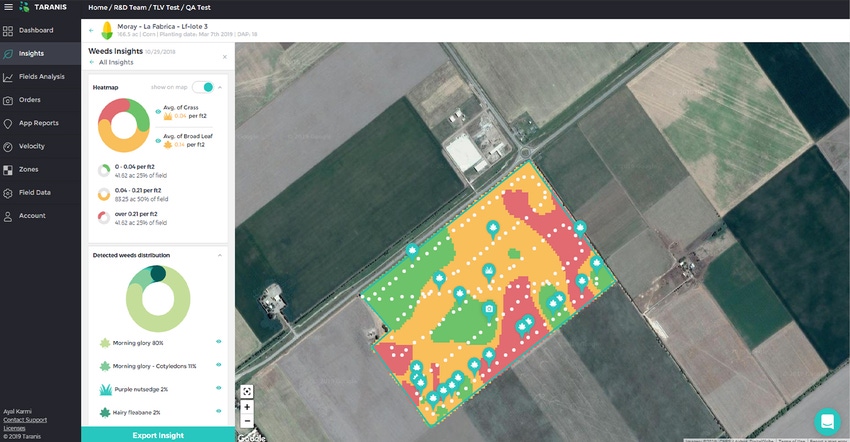July 10, 2019

Aerial imagery continues to offer farmers enhanced ways to scout crops, or better direct scouting efforts, to tackle in-season issues more quickly. The key is having that information linked to other decision-making tools in a single “home.”
The Climate Corporation has long been working to develop data partnerships that allow farmers to bring information from disparate locations into a single console. And recently, that effort expanded with ultra-high-resolution imagery from Taranis.
“The FieldView platform is stable and easy to use,” says Ofir Schlam, CEO, Taranis, an Israel-based imaging firm that provides submillimeter imagery. “Taranis and Climate can work together to provide the best output for the grower.”
Climate already has partnerships with more than 30 companies to trade and share information. Farmers are seeking a centralized platform that can not only house data but also help with improved decision-making. Taranis imagery steps that up with precision pictures that allow for easy machine identification of weeds. And that data will now flow into the FieldView platform.
“We’re the only ones doing submillimeter-scale imagery,” Schlam adds.
He notes that having data like these in the platform is valuable if farmers use them. He adds that with Taranis imagery, the company is providing “actionable reports farmers can use in decisions around inputs, selective herbicides, plant growth regulators and specific deliverables for their farms.”
Expanded market
The agreement between Taranis and Climate provides farmer-customers for both companies in the U.S., Brazil and Argentina. This is a two-way connection between FieldView and the Taranis system.
Adds Mark Young, Climate chief technology officer and head of product: “As advanced, high-resolution aerial imagery becomes of greater interest and value to farmers to more precisely monitor crop health and gain a deeper understanding of their fields, we look forward to partnering with Taranis to bring more farmers valuable imagery insights to enhance their operations.”
Drones and planes
In the U.S., Taranis is capturing imagery using drones, but Schlam explains the company can get the same resolution using planes — and does that in Brazil. “There, the fields are too large to use drones,” he observes. “But we can capture submillimeter imagery with our technology in either platform.”
The company can also work with satellite imagery, bringing information into reports for farm analysis.
Schlam explains that FieldView does have satellite imagery, but Taranis tech is complimentary. “Climate is really based on satellite imagery, their ingesting high resolution on their paid tools themselves. So once you opt in for this partnership, you get both platforms,” he says. “The key is return on investment.”
With the Taranis system, farmers can get a heat map of weed infestation in fields, even identifying resistant weeds. With this agreement, that data layer can flow into records in FieldView, enhancing what’s available to those who subscribe to the Taranis service.
For 2019, Climate has a stated goal of reaching 90 million paid acres. Adding services like Taranis (which charges a separate fee) enhances the FieldView tool as a one-stop location for data collection and analysis.
Taranis does focus on high-volume crops including corn, soybean, cotton, potatoes and sugarcane. The company recently closed $20 million in Series B funding to expand its global footprint.
Learn more at taranis.ag.
About the Author(s)
You May Also Like






